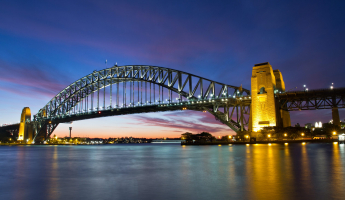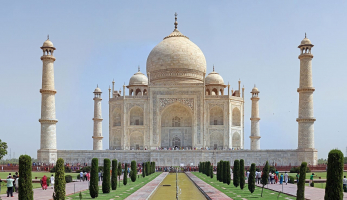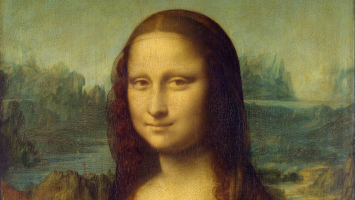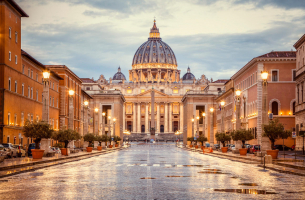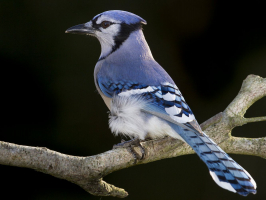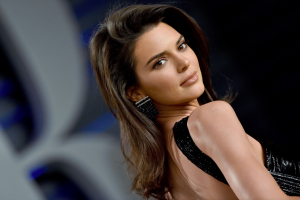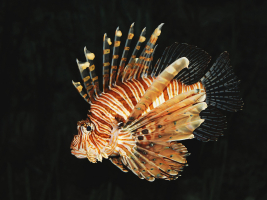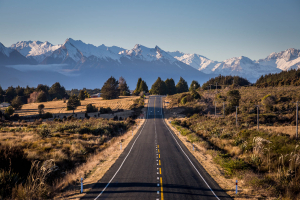Top 11 Most Famous Churches In The World
As they are designed and built to hold religious services and invoke and inspire the worship of God, churches have long counted amongst society’s most ... read more...important and impressive buildings. This is because religious leaders built large churches with spires reaching towards the heavens, and monumental facades covered in scenes from the bible to convey the majesty and power of God. Read on to see the most famous churches in the world.
-
Perched atop a tidal island that lies just off Normandy in the northwest of France, Mont St. Michel Abbey makes for one of the most arresting sights imaginable. The massive abbey with its charming chapels and cloisters lies above the cluttered historic buildings and halls of the town that tumble down the hillside.
The Benedictine abbey, which was founded in the tenth century, features various architectural marvels in the West Roman Empire, Roman, and Gothic styles. In that regard, the Mont-Saint-Michel could be viewed as a megastructure where the structures are stacked on top of one another in an effort to fit Benedictine operations into a constrained area. The monastery of Mont-Saint-Michel is awe-inspiring to see even from a distance of hundreds of meters away and appears to be too incredible to be real. Nevertheless, it has existed ever since work on it began in the tenth century. But don't just look at it from a distance; get close and you'll be taken back in time as you stroll through the abbey's hallways.
While monks and a monastery have been welcoming pilgrims to the mount since at least the 9th century, much of the abbey and its delightful Romanesque church were only completed in 1523. Nowadays, however, it is primarily Mont St. Michel’s spectacular setting and astounding historical sights that draw visitors to the abbey.
Location: France
Architect: William of Volpiano
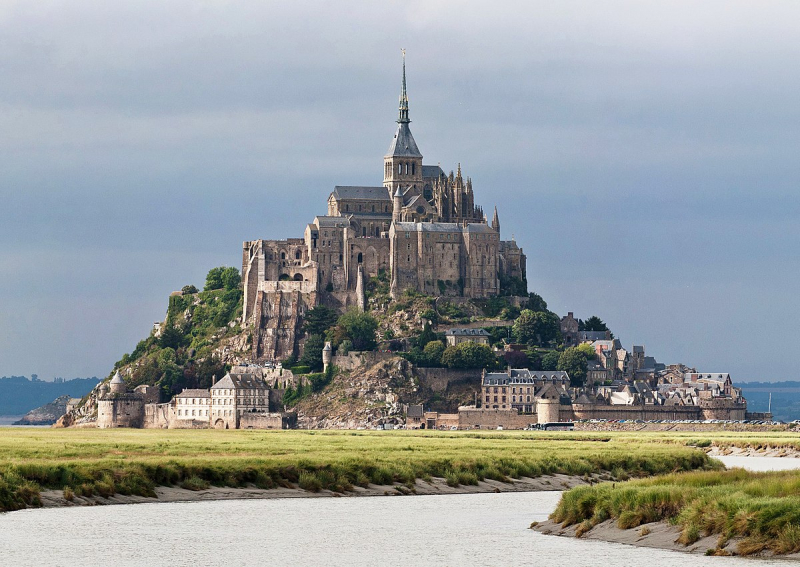
Wikipedia 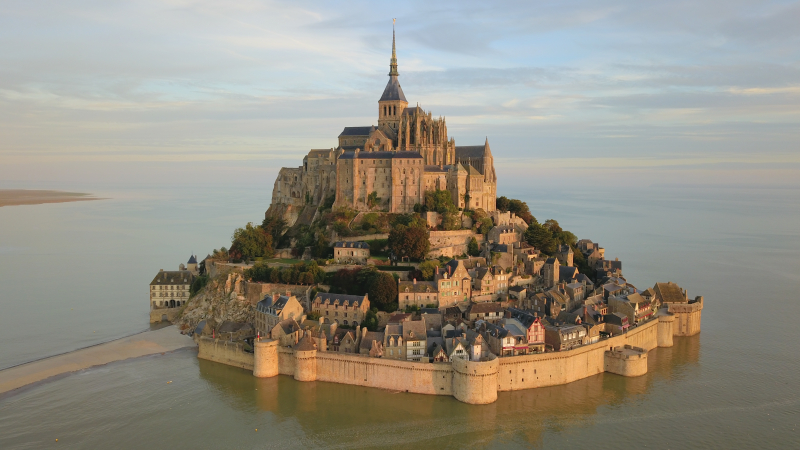
Wikipedia -
Built into the side of a rocky red hill in the Arizona desert, the Chapel of the Holy Cross looks out imperiously over its surroundings from its prominent viewpoint. Located just a short drive from Sedona, the church was built in 1957. It was inspired and commissioned by local rancher and sculptor Marguerite Brunswig Staude, and was designed by August K. Strotz of the firm Anshen & Allen, with Richard Hein of the firm as the project architect. The chapel is under the auspices of the episcopal see of the Roman Catholic Diocese of Phoenix and its ministry is conducted by St. John Vianney Parish, Sedona.
The Empire State Building, which was built in New York City in 1931, served as inspiration for its straightforward design and use of materials. The modern church is distinguished by its 27-meter-high iron cross that looks out over the valley, as well as by its angular shape and colorful windows that stand out pleasantly against the sandstone rocks.
This contemporary church was designed by Marguerite Brunswig Staude and finished in 1957. It stands out against the untamed surroundings thanks to its angular, stiff aspect. The 27-meter-high cross that stands in front of tinted glass at its southwest end is its most distinctive feature. Although its façade stands out against the rugged surroundings, its interior blends much better with the sandstone rocks.
Location: Arizona, USA
Architect: Marguerite Brunswig Staude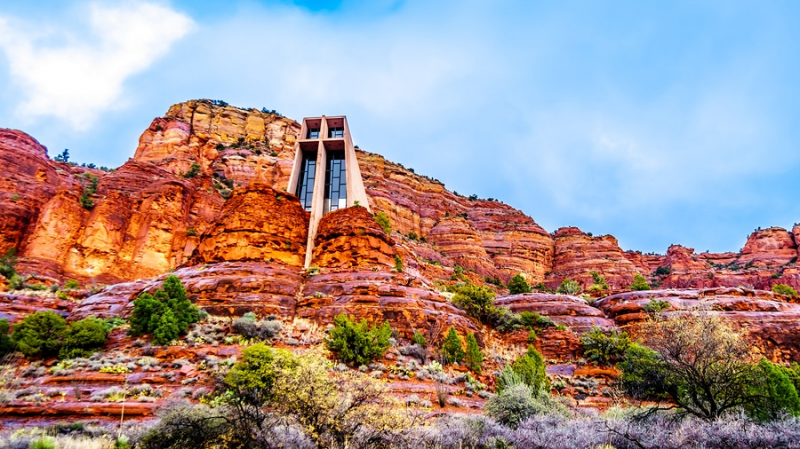
Canyon Villa 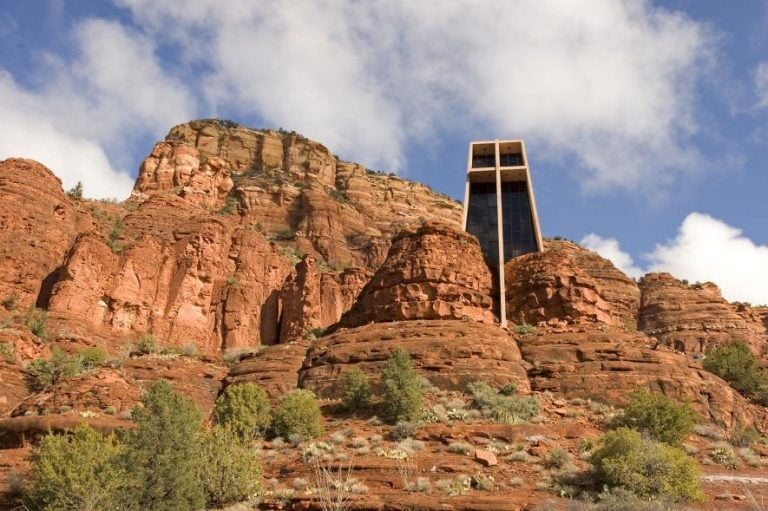
L'Auberge de Sedona -
The Basilica de la Sagrada Família, also referred to as the “Basilica of the Holy Family,” is a huge church in the center of the Spanish city of Barcelona. It’s world-famous because of its striking design and the fact that it remains unfinished today.
On 19 March 1882, construction of the Sagrada Família began under architect Francisco de Paula del Villar. In 1883, when Villar resigned, Gaudí took over as chief architect, transforming the project with his architectural and engineering style, combining Gothic and curvilinear Art Nouveau forms. Gaudí devoted the remainder of his life to the project, and he is buried in the church's crypt. At the time of his death in 1926, less than a quarter of the project was complete.
The style of the Sagrada Família is variously likened to Spanish Late Gothic, Catalan Modernism, or Art Nouveau. While the Sagrada Família falls within the Art Nouveau period, Nikolaus Pevsner points out that, along with Charles Rennie Mackintosh in Glasgow, Gaudí carried the Art Nouveau style far beyond its usual application as a surface decoration.
Pope Benedict XVI consecrated the church on November 7, 2010, and on his trip to Barcelona and Santiago de Compostela, he gave it the title of basilica. The church was added to the UNESCO World Heritage List in 1984 and was included in a 2007 list of Spain's 12 treasures.
Location: Barcelona, Spain
Architect: Francisco de Paula del Villar, Gaudí
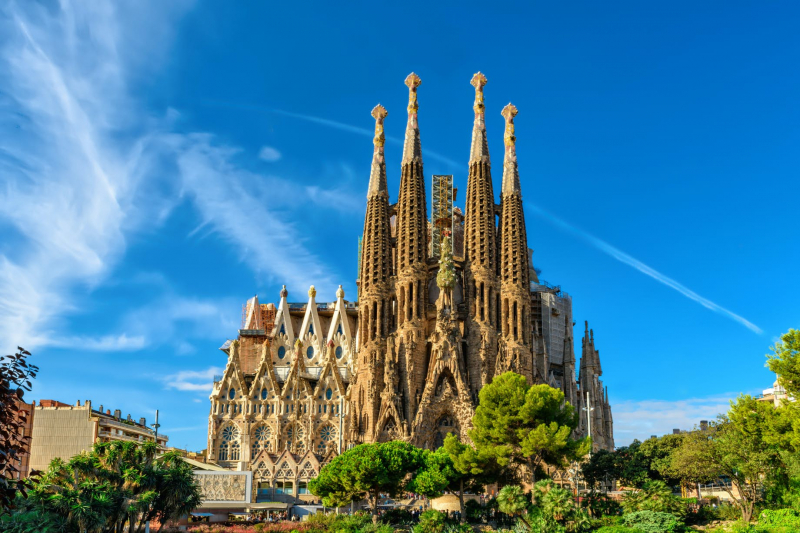
Lonely Planet 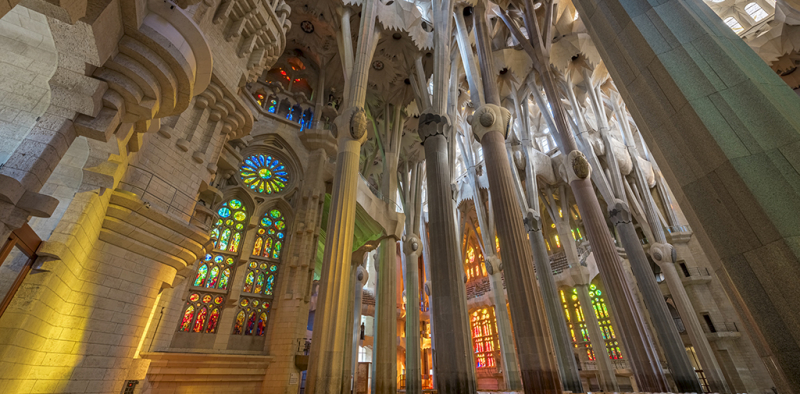
Blog Sagrada Família - - Sagrada Familia -
Because wood is far less suited to the tests of time than stone, there aren’t many ancient wooden churches left standing today. This contributes to the uniqueness of Norway's Borgund Stave Church. One of the best-preserved buildings of its kind in Europe, this gorgeous medieval wooden cathedral from 1250 seems like it belongs in the animated film Frozen. The term "stave church" refers to the vertical wooden boards that make up its walls. The four corner posts are supported by a stone foundation and joined to one another by ground sills.
Structurally, the building has been described as a "cube within a cube", each independent of the other. The inner "cube" is formed by continuous columns that rise from ground level to support the roof. The top of the arcade is formed by arched buttresses, knee jointed to the columns. Above the arcade, the columns are linked by cross-shaped, diagonal trusses, commonly dubbed "Saint Andrew's crosses"; these carry arched supports that offer the visual equivalent of a "second story". While not a functional gallery, this is reminiscent of contemporary second-story galleries of large stone churches elsewhere in Europe. Smaller beams running between these upper supporting columns help clamp everything firmly together. The weight of the roof is thus supported by buttresses and columns, preventing downward and outward movement of the stave walls.
There are four dragon heads carved onto the roof's gable ends, and there are carvings inside the archways, despite the fact that it may not appear as ornate from a distance as some stone churches. All of it contributes to the Borgund Stave Church's undeniably stunning design.
Location: Vestland, Borgund, Norway
Architect: Unknown
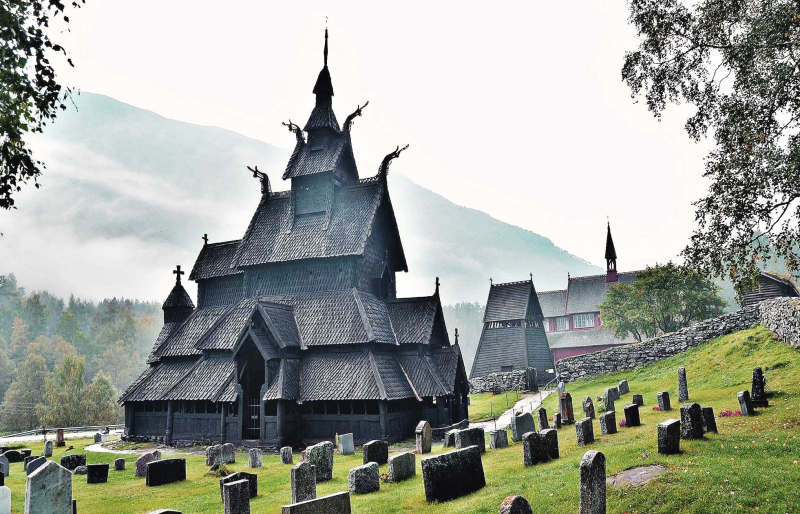
ArchEyes 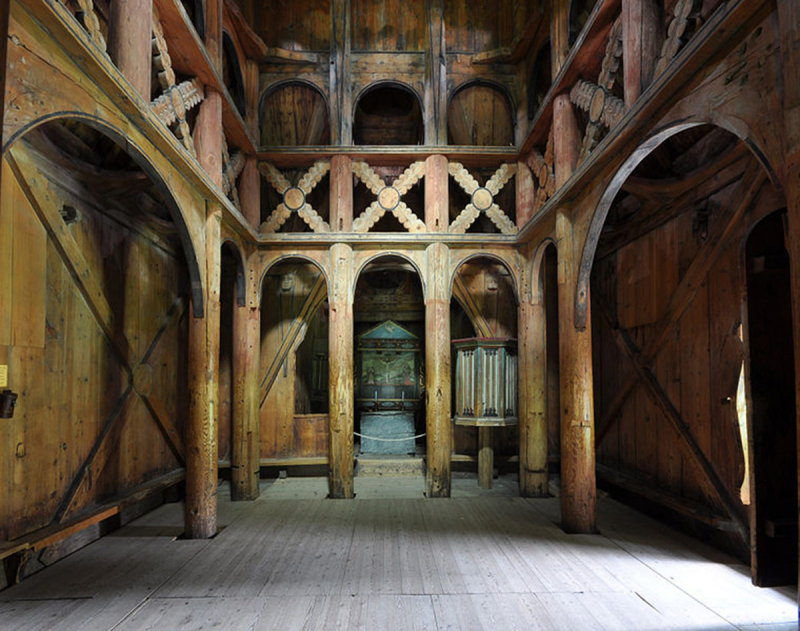
ArchEyes -
One of Georgia's most cherished and well-known sights is Gergeti Trinity Church, which is located in a tranquil and isolated area of the Caucasus with Mount Kazbek looming over it. The church, which is perched on a 2,170-meter-high peak, offers amazing views of the magnificent mountains that surround it and the glittering Chkheri River that flows below.
The Gergeti Trinity Church was built in the 14th century by an unknown architect and is the only cross-cupola church in Khevi province. The separate bell tower dates from the same period as the church itself but was built somewhat later. Its isolated location on top of a steep mountain surrounded by the vastness of nature has made it a symbol for Georgia. The iconic view of the church and Mount Kazbek is one of the best examples of the harmonic combination of architecture and the landscape, so typical for the architecture of Georgia. The church ensemble includes the church itself, the bell tower, and the surrounding wall. The church is a cross-in-square temple with three rectangular and one rounded (containing the apse) arms, and two entrances, from the south and from the west. Each arm has a window. Additional five windows of the lobate provide sufficient illumination. The lobate is rather stumpy, slightly narrowing in the upper part. The facade is clad in dark-grey stone. Only traces of the original murals remain.
Visitors can drive to the top of the mountain or climb the steep mountainside to get to the chapel. The Gergeti Trinity Church is a photographer's paradise because of its remote location and breathtaking beauty on display.
Location: Oni, Georgia
Architect: Unknown
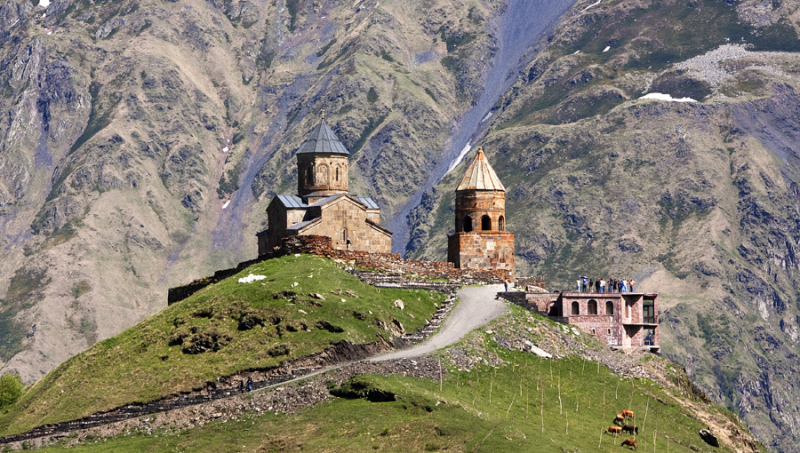
Wikipedia 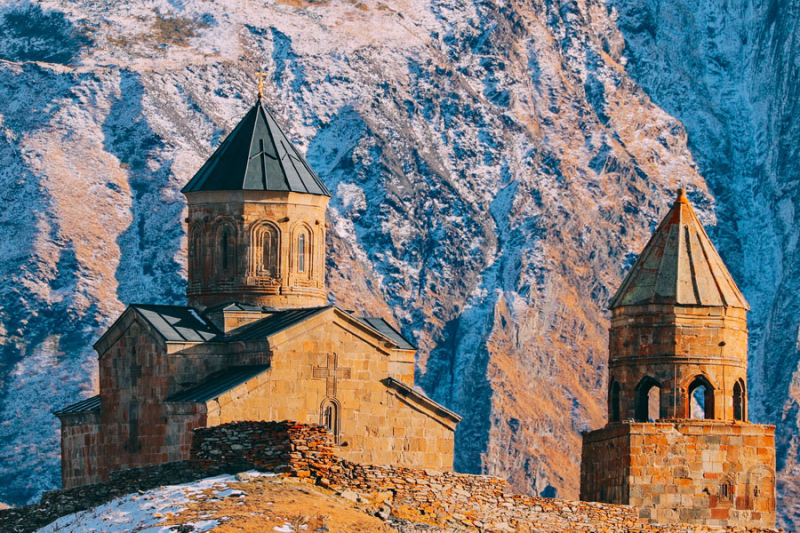
Advantour -
A Roman temple from antiquity, the Pantheon, was converted into a Catholic church in the seventh century. The "Santa Maria Rotonda" is the name of the church, which was built in honor of "St. Mary and the Martyrs."
The original temple was constructed as early as the reign of Roman Emperor Augustus but was rebuilt several times, first by Trajan and finally completed by Hadrian in the year 126 A.D. The main building is famous because it has an opening at the top of its massive dome. The building is cylindrical with a portico of large granite Corinthian columns (eight in the first rank and two groups of four behind) under a pediment. A rectangular vestibule links the porch to the rotunda, which is under a coffered concrete dome, with a central opening (oculus) to the sky. Almost two thousand years after it was built, the Pantheon's dome is still the world's largest unreinforced concrete dome. The height of the oculus and the diameter of the interior circle are the same, 43 meters (142 ft).
The Pantheon is a state property, managed by Italy's Ministry of Cultural Heritage and Activities and Tourism through the Polo Museale del Lazio. In 2013, it was visited by over 6 million people.
Location: Roma, Italy
Architect: Trajan, Hadrian
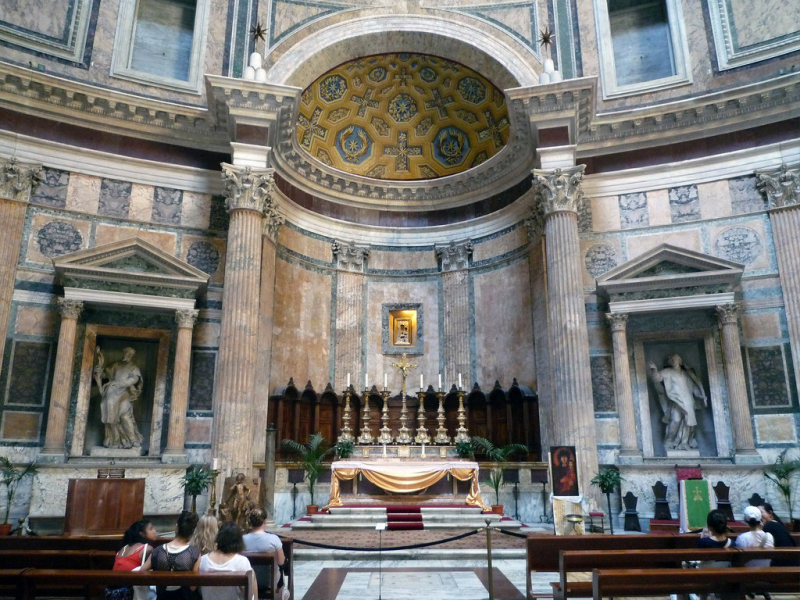
Smarthistory 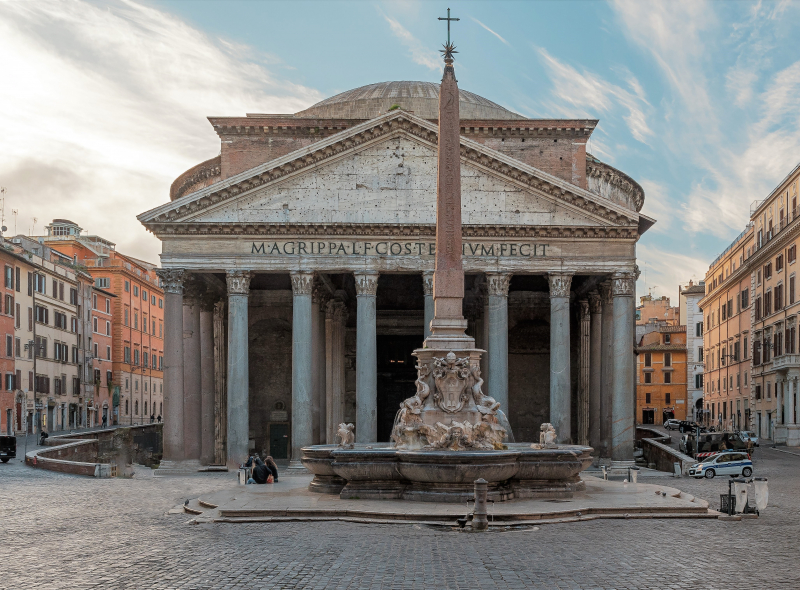
Wikipedia -
The official and colloquial names for Cologne Cathedral are "Cathedral Church of Saint Peter" and "Dom," respectively. It's a magnificent example of Gothic architecture and one among Germany's most significant religious structures. It was named a World Heritage Site in 1996 and is a well-known example of Gothic architecture and German Catholicism. With an average of 20,000 visitors per day, it is Germany's most popular landmark.
The cathedral's construction began in 1248, and when it was finished in 1880, it was the tallest structure in the world. This title belonged to the cathedral for only four years when the Washington Monument overtook it. It continues to be the world's tallest twin-spired church as of this writing.Construction of Cologne Cathedral began in 1248 but was halted in the years around 1560, unfinished. Attempts to complete the construction began around 1814 but the project was not properly funded until the 1840s. The edifice was completed to its original Medieval plan in 1880. The design of Cologne Cathedral was based quite closely on that of Amiens Cathedral in terms of the ground plan, style, and the width-to-height proportion of the central nave. The plan is in the shape of a Latin Cross, as is usual with Gothic cathedrals. It has two aisles on either side, which help to support one of the very highest Gothic vaults in the world, being nearly as tall as that of the Beauvais Cathedral, much of which collapsed. Externally the outward thrust of the vault is taken by flying buttresses in the French manner.
Location: Köln, Germany
Architect: Barbara Schock-Werner, Master Gerhard, Peter Füssenich, Arnold Wolff, Ernst Friedrich Zwirner, Willy Weyres, Richard Voigtel
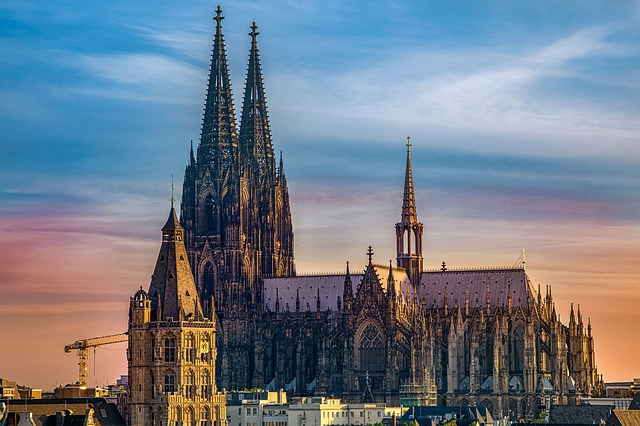
AESU 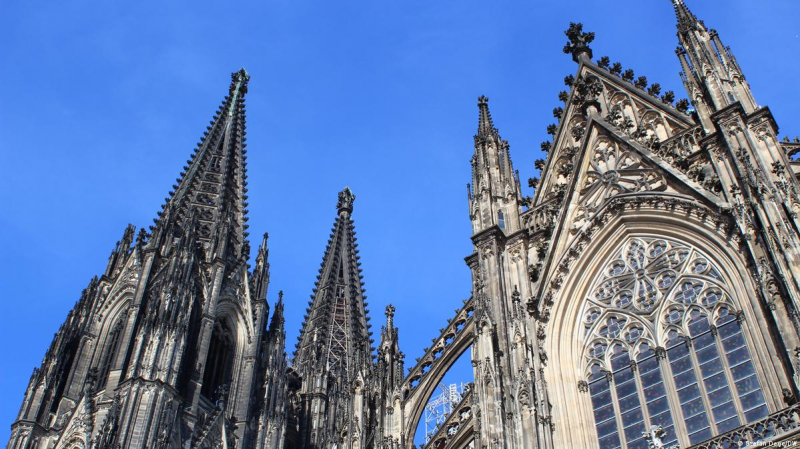
DW -
Lincoln Cathedral is officially known as the “Cathedral Church of the Blessed Virgin Mary of Lincoln” and is located in the town of Lincoln in the East Midlands of England. It’s located right across another medieval structure, the Lincoln Castle.
The cathedral's construction began in the year 1072, and when it was finished in the year 1311, it had surpassed the Great Pyramid of Giza as the highest structure in the world. It maintained this record for a total of 248 years, and it would have continued to hold it had its spire survived until the Eiffel Tower's construction in 1889.
One of the pinnacles of Gothic architecture, Lincoln Cathedral is a beautifully coordinated display of decorative art. The west front is simply breathtaking, with its Norman arches set in a 13th-century screen. The carving on the south porch is noteworthy for its exquisite workmanship. The porch door is a "Judgement Portal" that features a central image of Christ flanked by intricately carved angels, as well as an array of souls ascending to paradise or being dragged by demons downward to hell. A carving of a king and queen, maybe Edward I and Eleanor of Castle or his second wife Margaret of Valois, is located right next to the porch.
The nave is awe-inspiring, with slender pillars of Purbeck marble rising up to the painted ceiling high above. The north and south transepts each boast a huge rose window filled with stained glass. Because of its beauty, Lincoln Cathedral attracts thousands of tourists to visit.
Location: Lincoln, England
Architect: Unknown
BBC 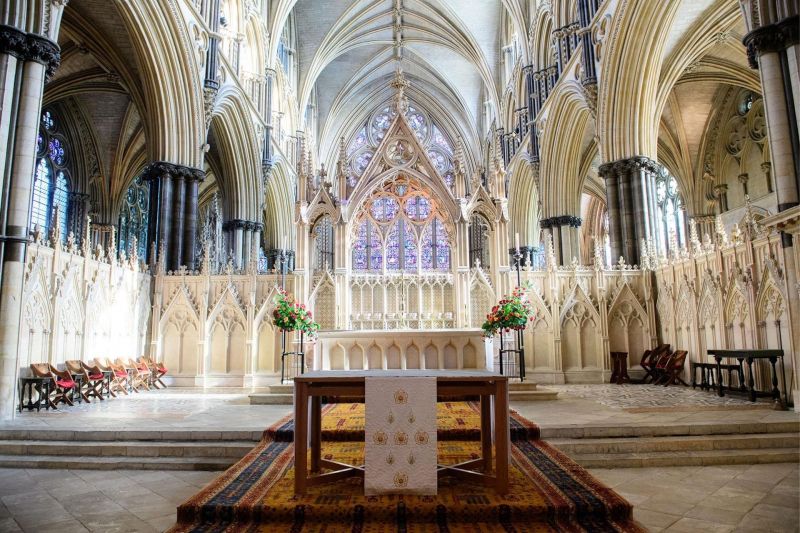
Visit Lincolnshire -
St. Basil's Cathedral, one of the most well-known structures in the world, genuinely appears to have simply been plucked from a collection of children's fairytales. Red Square in the center of Moscow is dominated and defined by the stunning structure, which was constructed in 1561 under the direction of Ivan the Terrible.
Part of its distinctive appearance can be attributed to the colorful domes and vivid redbrick towers. The domes belong to ten different chapels within the cathedral, and each dome is a symbol of the assault on the city of Kazan. The design of the cathedral draws from architectural designs found in Jerusalem and holds strong religious meanings. When seen from the top, the eight domes surrounding the ninth dome in a circular fashion appear to form a star. Although it is famed for its distinctive appearance, the inside is just as magical as icons and murals cover every surface. Secularised in 1929 by the Soviets, who actually considered demolishing it, St. Basil’s Cathedral is now an important symbol of the country.
The inside of the cathedral is small and evocative despite its lack of space. You may explore the structure's medieval past by navigating a maze of dimly lit passages between chapels.
Location: Moscow, Russia
Architect: Barma and Postnik
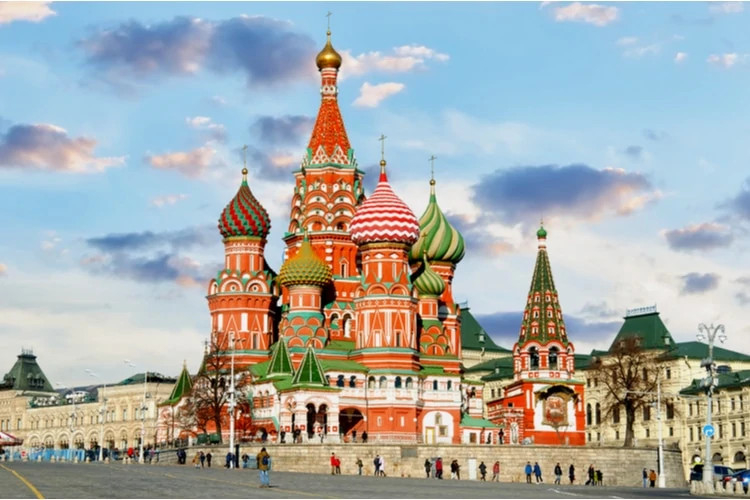
Swedish Nomad 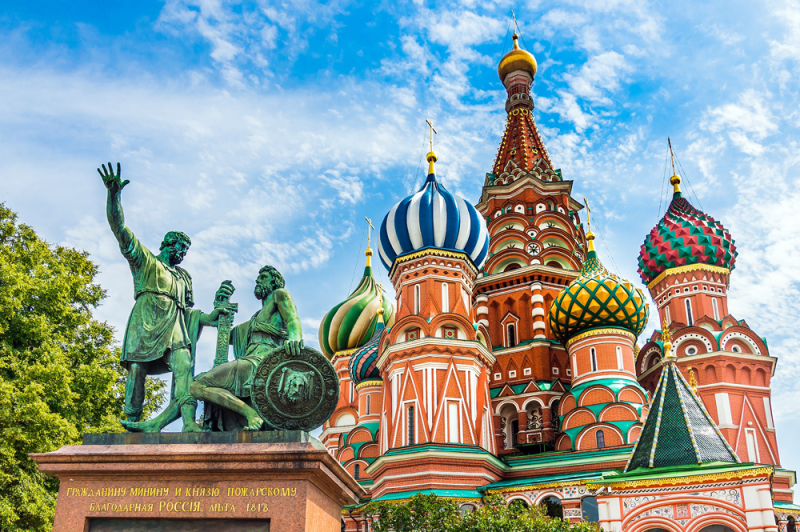
Russia Beyond -
As Vatican City is home to the pope and is the seat of the Catholic church, it only stands to reason that it also boasts the largest church in the world: St. Peter’s Basilica. Commissioned by Pope Julius II to be the grandest building in Christendom, the basilica was built between 1506 and 1626, with legendary figures such as Bramante, Raphael, and Michelangelo all contributing.
The magnificent Renaissance-style church, which bears the name of the revered saint whose tomb is located inside, boldly displays a huge facade and dome, with the colonnade-lined St. Peter's Square leading up to it. Its marbled floors extend out in front of you in all directions, displaying magnificent statues, ancient artwork, and brilliant jewels. St. Peter's Basilica, unquestionably one of the most stunning buildings in the world, is an architectural marvel with magnificent artwork for you to enjoy.
The current building's construction began in 1506 and wasn't finished until 1526. One of Jesus' Twelve Apostles, Saint Peter, and the first Bishop of Rome were both interred at the location, according to the Catholic Church.
Location: Vatican CityArchitect: Bramante, Raphael, and Michelangelo
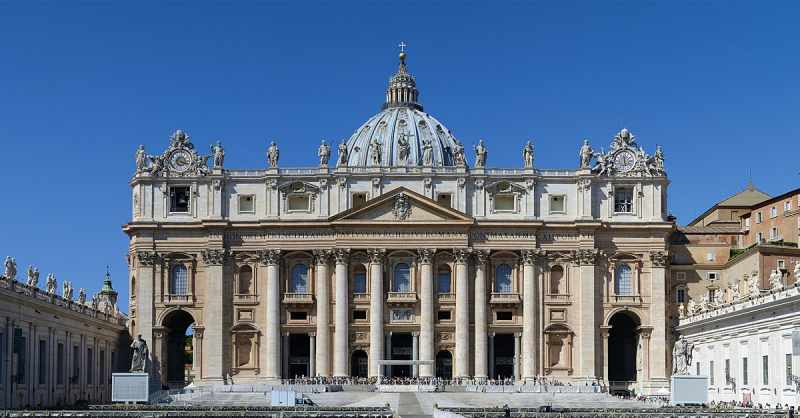
Wikipedia 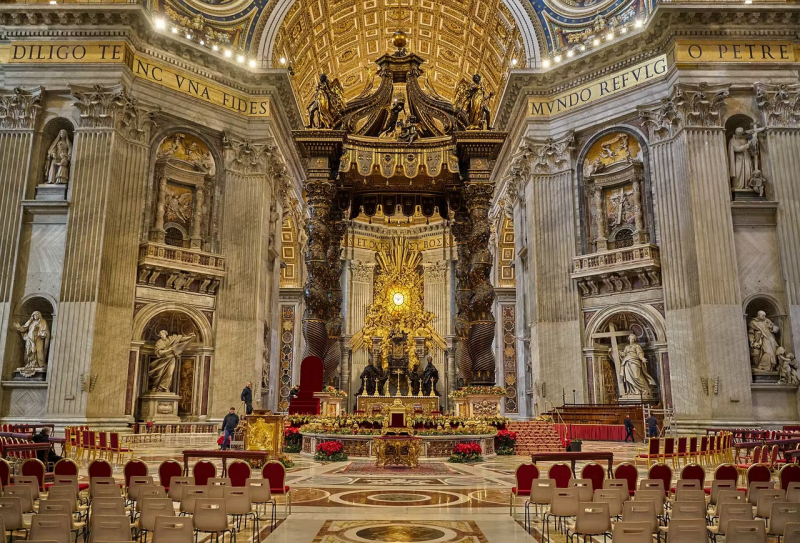
St. Peter's Basilica Tickets -
Hidden in a canyon on the Guaitara River in Colombia, Las Lajas Sanctuary’s gorgeous Gothic Revival-style architecture makes for a magical sight. Built between 1916 and 1949, the spectacular sanctuary lies on a 130-foot-high bridge that spans the river, with a beautiful waterfall twinkling beside it. It is a famous pilgrimage site for Christians from both Colombia and neighboring Ecuador, due to a Marian apparition that is purported to have taken place here in the 18th century.
Las Lajas Sanctuary is an example of the Gothic Revival style, with a vaulted ceiling, buttresses, and spires. The inside of the church is white with gold trim, and it is ninety feet long and fifty feet wide. The present church was built in a Gothic style between 1916 and 1949 (33 years). The name Laja (slab) comes from the name of a type of flat sedimentary rock similar to shale and slate.
Las Lajas Sanctuary is 330 feet tall from the bottom of the Guáitara Canyon against one side of the canyon on a hill. A 160-foot-tall bridge over the Guáitara River connects the church to the other side of the canyon. The entrance to the church is 150 feet over the canyon, and from above, the roof of Las Lajas Sanctuary resembles a Catholic cross.
Location: Guaitara River, Colombia
Architect: Lucindo Espinosa, J. Gualberto Pérez
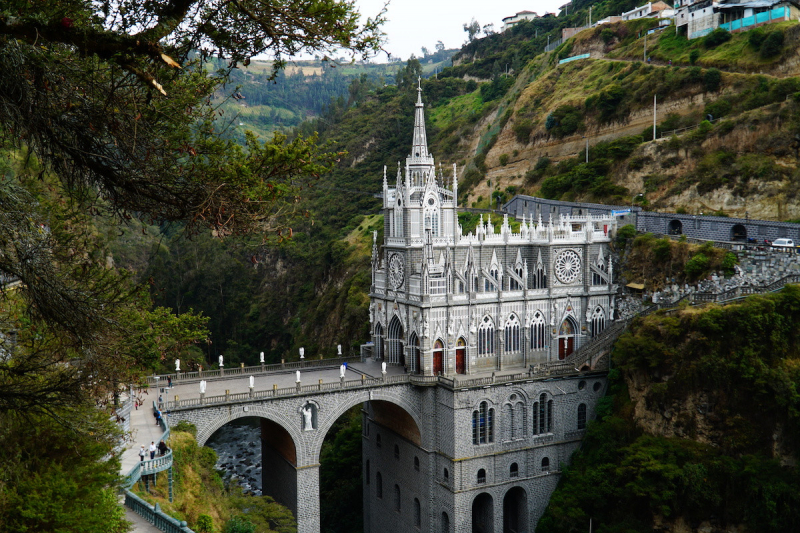
MasterClass 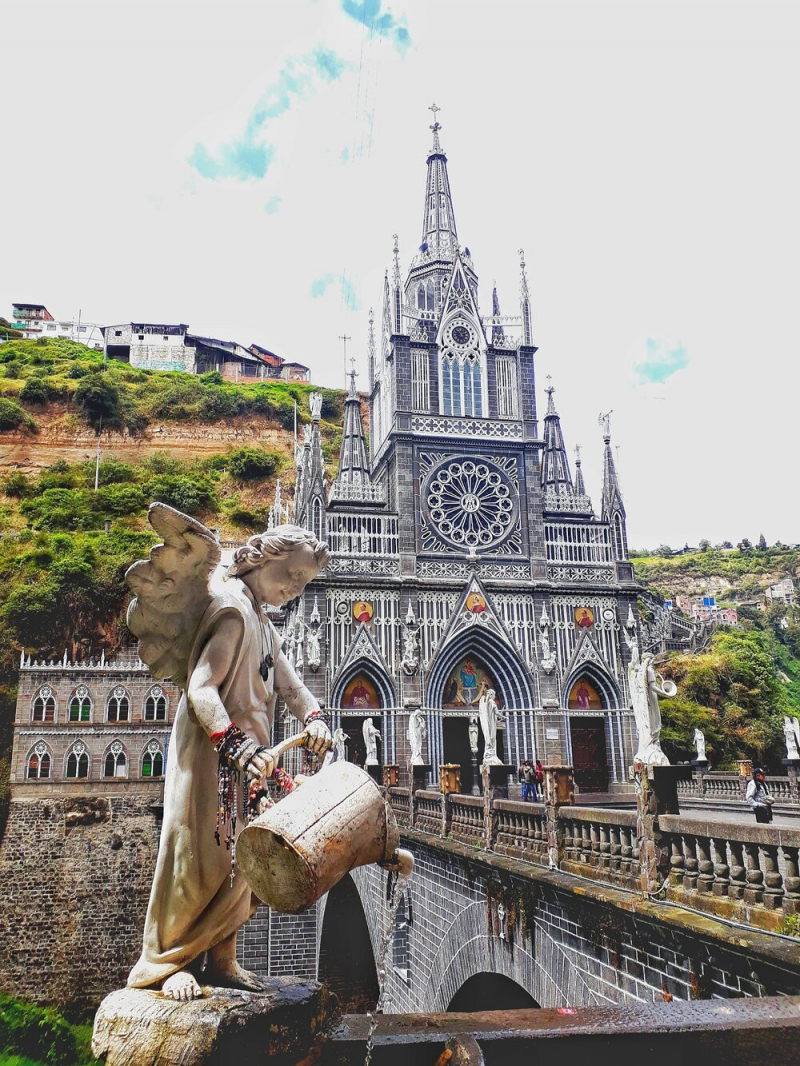
WANDERLUST IN THE WILD













